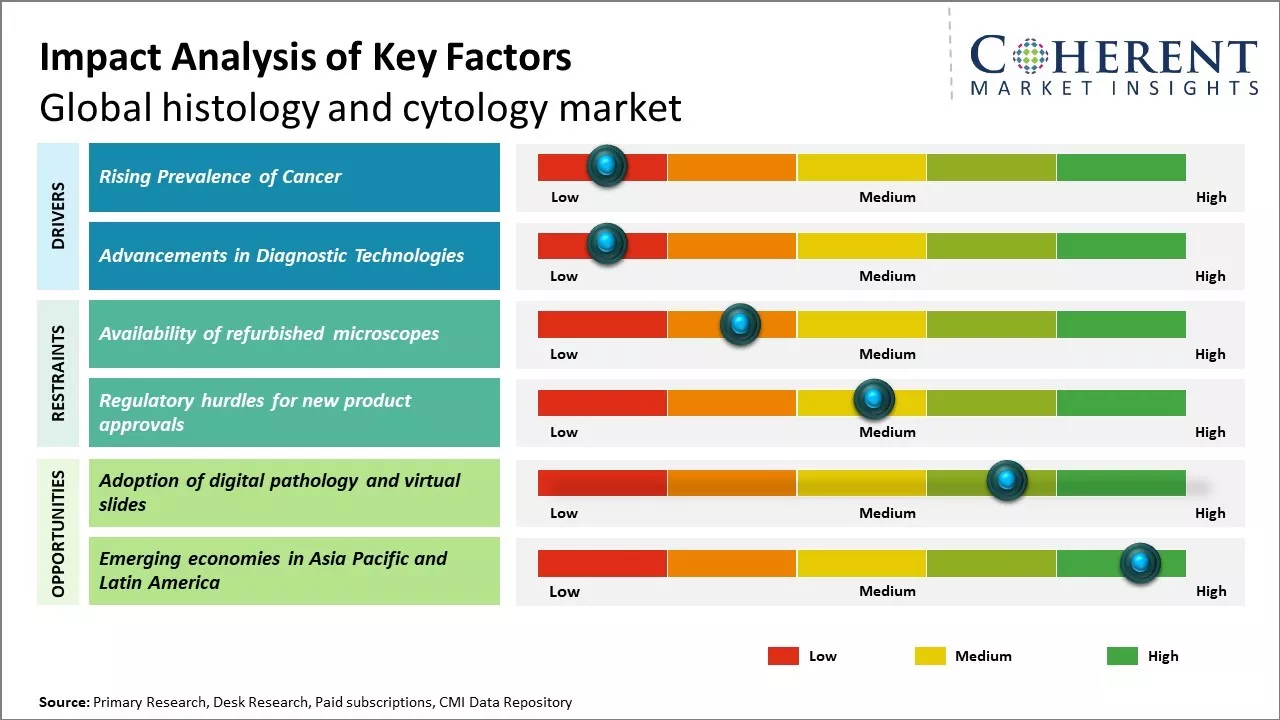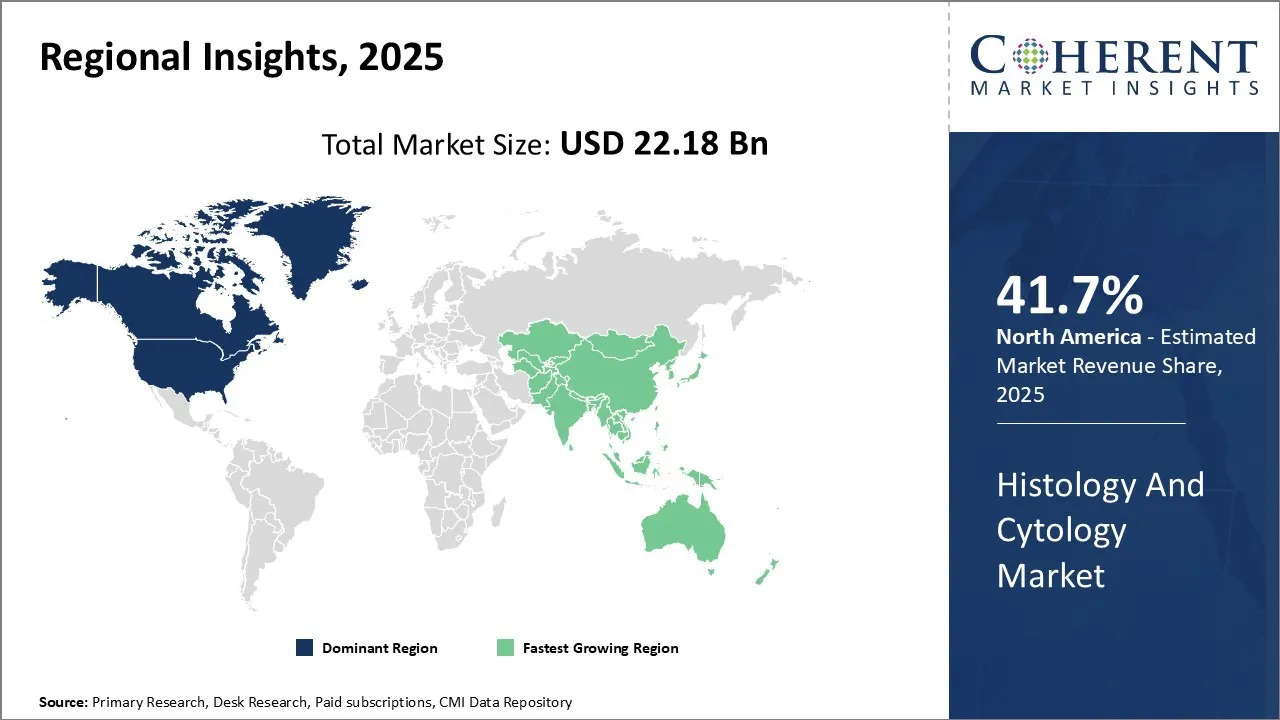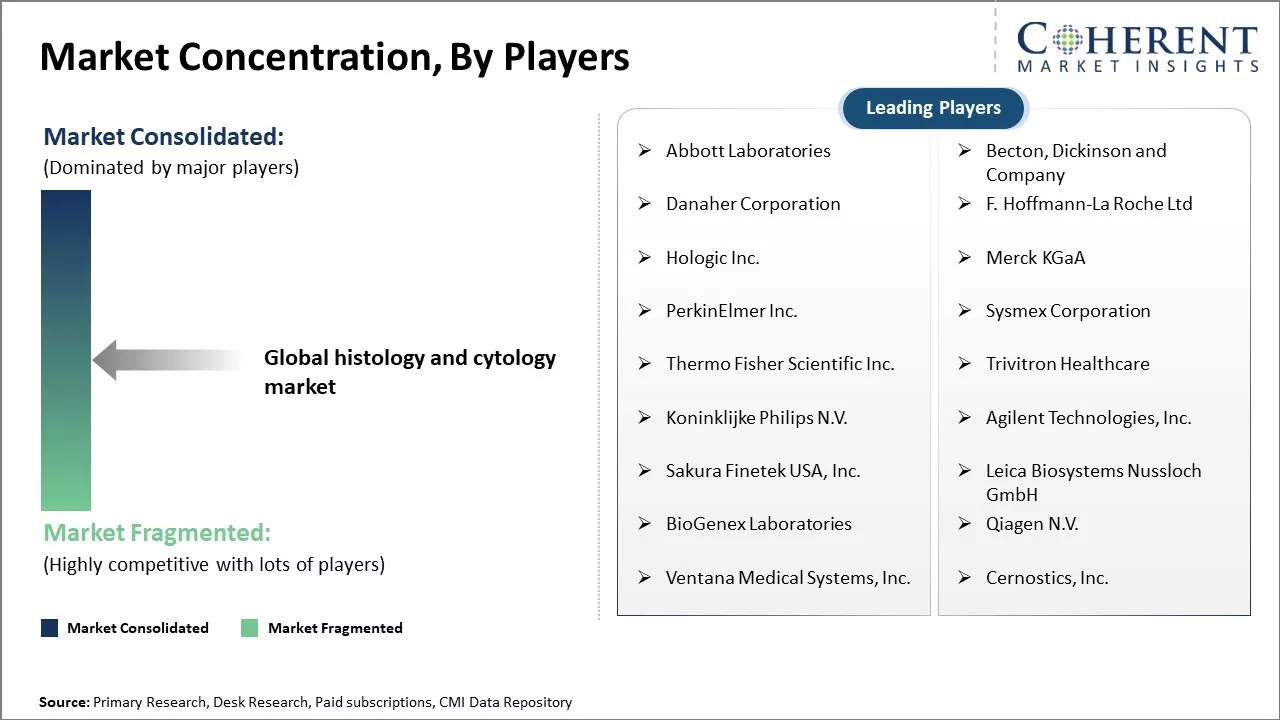Global histology and cytology market is estimated to be valued at USD 22.18 Bn in 2025 and is expected to reach USD 54.18 Bn by 2032, exhibiting a compound annual growth rate (CAGR) of 13.6% from 2025 to 2032.

To learn more about this report, Download Free Sample
Global histology and cytology market encompasses products and services used to examine tissues and fluid samples from the human body. This includes instruments, consumables and reagents used for specimen processing, slide preparation, microtome sectioning, staining, slide scanning and imaging. The global market also involves digital pathology solutions, workflow management platforms and other software programs that help pathologists analyse samples, diagnose diseases and keep records of patient health conditions. Global diagnoses of diseases are on the rise, mainly because of the increasing number of cancer and other chronic diseases worldwide. With a growing number of patients and difficult health problems to attend to, healthcare is increasingly emphasizing timely and correct diagnosis. This situation has resulted in greater use of cytology and histology tools which allow for accurate diagnosis of disease at the cellular stage.
|
Current Events |
Description and its impact |
|
Geopolitical Instability and Supply Chain Disruptions |
|
|
Demographic and Epidemiological Trends Affecting Diagnostic Demand |
|
|
Economic Factors and Healthcare Investment Trends |
|
Uncover macros and micros vetted on 75+ parameters: Get instant access to report
AI algorithms excel at identifying subtle morphological patterns that can be easily missed by the human eye, reducing diagnostic errors. For example, in cytology, AI-driven platforms have demonstrated a significant reduction in false negatives in cervical cancer screening, improving early detection rates. In February 2024, Hologic, Inc. announced that its Genius™ Digital Diagnostics System, featuring the Genius™ Cervical AI algorithm, received clearance from the U.S. Food and Drug Administration (FDA). This marks it as the first and only FDA-approved digital cytology system that integrates deep-learning AI with advanced volumetric imaging technology to assist in detecting precancerous lesions and cervical cancer cells.
In December 2024, the Belgian National Institute for Health and Disability Insurance (INAMI-RIZIV) has updated the cervical cancer screening program with the following reimbursement guidelines:
The primary screening method will shift from cytological examination to HPV (Human Papillomavirus) testing.
Cytological examination remains the recommended primary screening test and is reimbursed every three calendar years.
This revised screening and reimbursement approach aims to optimize early detection while minimizing unnecessary interventions and costs.
In terms of type of examination, histology segment is estimated to contribute the highest market share of 55.5% in 2025, owing to its precise diagnostic ability. Histology allows pathologists to examine cell and tissue samples under a microscope to identify abnormalities, assess progression of diseases like cancer, and determine the accurate type and stage of many illnesses. This precise diagnostic information is invaluable to physicians for determining appropriate treatment plans and monitoring disease response over time. Histology enables visualization of cellular-level details that other testing methods cannot match. By staining and imaging tissue sections, pathologists can see the exact arrangement of cells and cellular structures. This permits diagnosis of diseases that may show similar clinical symptoms but require different treatments based on their histological presentation. Histology also supports the most accurate cancer subtyping needed for personalized treatment selection. For diseases with multiple potential types or stages, histology offers definitive diagnosis not available through other means.
Innovations such as label-free histology using Photon Absorption Remote Sensing Microscopy have enhanced diagnostic efficiency by providing high-resolution images without the need for traditional staining methods, preserving valuable tissue samples for further analysis. Additionally, the integration of AI-powered platforms like DCS PathIMS has streamlined breast cancer diagnostics by automating histological grading, thereby reducing human bias and workload. This is further propelling the histology and cytology market growth.
In the application segment, the market is categorized into Breast Cancer, Cervical Cancer, Bladder Cancer, Lung Cancer, and Others. Breast and Cervical cancer diagnostics are witnessing increased adoption globally. This trend is attributed to growing cancer screening initiatives and early detection programs, which have heightened the demand for histology and cytology services in these areas. The implementation of organized screening programs and the development of advanced cervical cancer diagnostic tests have played a crucial role in facilitating early treatment planning.
For instance, Noul Co., Ltd. introduced its new AI-based cervical cell screening system, miLab™ CER, at the International Congress of Cytology (ICC) 2025 in Florence. This system improved cervical cancer diagnostic and was able to detect more than 90% of ASCUS or greater lesions while correctly reporting in only 4% of other scenarios. From staining the blood through imaging and computerized results, the entire process with the miLab™ CER is fully automatic and fast. This technology is being introduced into clinics to help find and treat cervical cancer early, mainly where medical resources are scarce.
In terms of product, instruments and analysis software system segment is estimated to contribute the highest market share of 53.7% in 2025, owing to rapidly growing and diversifying diagnostic needs. Advanced digital microscopy systems, automated slide scanning, and sophisticated image analysis software are transforming pathology workflows. Whole slide imaging systems powered by machine learning are improving detection of incidental findings. Multispectral and fluorescence capabilities expand diagnostic applications to new areas. Growing demand for specialized stains, immunohistochemistry, in situ hybridization, and molecular tests drives needs for flexible, high-throughput instrumentation.
Software solutions help integrate diverse data types for correlative analysis and reporting. As pathologists take on more complex diagnostic and research duties, there is huge demand for sophisticated tools that enhance efficiency, accuracy, and data sharing capabilities. Advancing technologies also support new applications like liquid biopsy and companion diagnostics. Instrument vendors must continually release innovative products to address the rapidly changing diagnostic landscape. The integration of sophisticated imaging software is revolutionizing histology and cytology diagnostics. Thermo Fisher Scientific's Celleste™ 6 Image Analysis Software exemplifies this advancement by offering a comprehensive suite of tools for analysing complex biological images, which is further contributing to the histology and cytology market revenue.
In terms of test type, microscopy tests segment is estimated to contribute the highest histology and cytology market share of 42.5% in 2025, owing to its widespread foundation applications and ability to support evolving diagnostic needs. Microscopy has long been the core technology enabling cytopathology and anatomic pathology. Pap smears, bronchial wash cytology, fine needle aspiration interpretation, and surgical pathology review all rely primarily on traditional and digital microscopy. Though newer molecular tests for mutations and gene expressions are increasingly important, microscopy remains essential for proper tissue selection, interpretation of molecular results, and correlation with clinical information. Microscopy also guides screening and triage decisions for when robust molecular testing may be applied. Advancing digital microscopy platforms compatible with artificial intelligence and image analysis can expand potential microscopy-based applications into new areas including liquid biopsies, intraoperative assessments, and automated screening, further accelerating the histology and cytology market demand.
In April 2025, Honeywell introduced Digital Holographic Microscopy, an AI-powered technology that quickly counts and classifies microscopic particles. This innovation can significantly reduce diagnosis time for infections in at-home peritoneal dialysis patients, who currently face 1–2 day delays waiting for lab results, potentially preventing condition worsening.
The market comprises Hospitals and Clinics, Academic and Research Institutes, Clinical Diagnostics Centres, and Others where Hospitals and clinics are projected to be the leading end users in the histology and cytology market, driven by the increasing volume of in-patient diagnostic procedures. The adoption of advanced diagnostic technologies in clinical settings has further bolstered this segment's growth. The integration of digital pathology systems and AI-driven diagnostic tools in hospitals and clinics has improved diagnostic accuracy and efficiency, making them pivotal end users in the market. The establishment of advanced diagnostic laboratories is significantly bolstering histology and cytology services within hospitals and clinics.
A notable example is the inauguration of Metropolis Star Lab Kenya Limited's Regional Reference Laboratory in Nairobi. Spanning over 6,000 square feet, this state-of-the-art facility is equipped to process approximately 35,000 to 40,000 samples per month, encompassing specialties such as haematology, microbiology, molecular biology, special chemistry, immunology, histology, and cytology. This development underscores the growing emphasis on enhancing diagnostic capabilities in clinical settings, thereby improving patient outcomes through timely and accurate disease detection.

To learn more about this report, Download Free Sample
North America continues to lead the global histology and cytology market, accounting for approximately 41.7% of the market share in 2025. This dominance is attributed to the region's advanced healthcare infrastructure, high healthcare expenditure, and the presence of leading medical device and pharmaceutical companies. The integration of artificial intelligence (AI) and digital pathology solutions is enhancing diagnostic accuracy and efficiency. A well-established healthcare infrastructure and research landscape has supported advanced diagnostics practices. Pathology laboratories in the region are equipped with state-of-the-art technologies for tissue sample analysis. Demand for digital and AI-enabled platforms is growing from hospitals and diagnostic chains to improve workflow and turnaround times. This has encouraged domestic manufacturers to focus on developing solutions catering to this need. North America also has a favorable regulatory environment that approves new technologies faster, allowing the region access to latest diagnostic tools in histology and cytology. Additionally, the adoption of automated and AI-driven diagnostic systems is accelerating, as evidenced by Wondfo Biotech’s new product launches, including the fully automatic chemiluminescence immunoassay analyzer FC-2100, showcased at the 76th Annual American Congress of Clinical Chemistry and Exposition of Clinical Laboratory Medicine in 2024. This is further adding to the histology and cytology market revenue.
Asia Pacific region has emerged as the fastest growing histology and cytology market globally. Rapid improvements in healthcare access across developing nations like India and China have boosted demand for pathology testing. Favorable government initiatives to modernize diagnostic capabilities and expand insurance coverage drives the market growth. Increasing investments by international players to establish local manufacturing presence can make advanced solutions more affordable in the region. Sysmex Corporation released its Clinical Flow Cytometry System in Japan in May 2023 to enhance the efficiency of testing and diagnostic performance in clinical laboratory settings.
The United States histology and cytology market is witnessing significant advancements, particularly in digital pathology solutions. A notable development is OptraSCAN's launch of its OnDemand Digital Pathology subscription service, which offers whole slide digital scanners (Brightfield/Fluorescence) with capacities ranging from 15 to 480 slides. This service aims to make digital pathology more accessible and cost-effective for laboratories of varying sizes, enhancing diagnostic efficiency and accuracy. Such innovations reflect the broader trend in the U.S. towards integrating advanced technologies in histology and cytology practices. The adoption of digital and AI-driven diagnostic tools is transforming traditional workflows, enabling faster and more precise analyses. This shift is supported by a robust healthcare infrastructure and a regulatory environment that facilitates the approval and implementation of cutting-edge diagnostic solutions. As a result, the U.S. continues to lead in the global histology and cytology market, setting benchmarks for technological integration and diagnostic excellence.
India's histology and cytology market is undergoing a transformative phase, propelled by technological advancements and a growing emphasis on early disease detection. This move underscores India's capability in providing advanced diagnostic services on a global scale, reflecting the country's growing expertise in histology and cytology diagnostics. Domestically, the integration of artificial intelligence (AI) in medical diagnostics is gaining momentum.
The AI in Medical Diagnostics Market in India is witnessing rapid growth, driven by an increasing demand for early and accurate disease detection, a rising burden of chronic illnesses, and a shortage of skilled healthcare professionals. With a growing reliance on AI-powered radiology, pathology, and predictive analytics, hospitals and diagnostic centers are integrating AI solutions to enhance efficiency and reduce turnaround times. In January 2025, Ampath, in collaboration with Parashar Pathology Clinic, inaugurated a state-of-the-art pathology laboratory in Meerut, India. Equipped with advanced technologies, the facility offers over 2,500 diagnostic tests, including cytology, histopathology, and molecular diagnostics, enhancing diagnostic capabilities in the region.

To learn more about this report, Download Free Sample
| Report Coverage | Details | ||
|---|---|---|---|
| Base Year: | 2024 | Market Size in 2025: | USD 22.18 Bn |
| Historical Data for: | 2020 To 2024 | Forecast Period: | 2025 To 2032 |
| Forecast Period 2025 to 2032 CAGR: | 13.6% | 2032 Value Projection: | USD 54.18 Bn |
| Geographies covered: |
|
||
| Segments covered: |
|
||
| Companies covered: |
Abbott Laboratories, Becton, Dickinson and Company, Danaher Corporation, F. Hoffmann-La Roche Ltd, Hologic Inc., Merck KGaA, PerkinElmer Inc., Sysmex Corporation, Thermo Fisher Scientific Inc., Trivitron Healthcare, Koninklijke Philips N.V., Agilent Technologies, Inc., Sakura Finetek USA, Inc., Leica Biosystems Nussloch GmbH, BioGenex Laboratories, Qiagen N.V., Ventana Medical Systems, Inc., Cernostics, Inc. |
||
| Growth Drivers: |
|
||
| Restraints & Challenges: |
|
||
Uncover macros and micros vetted on 75+ parameters: Get instant access to report
Global histology and cytology market growth is driven by rising prevalence of various types of cancers worldwide. Cancer has become one of the leading causes of mortality with an estimated 9.6 million deaths in 2018. The occurrence of cancer is increasing at an alarming rate due to factors such as growing geriatric population, increasing adoption of unhealthy lifestyle habits such as smoking, drinking, lack of physical activity, changing dietary patterns, rising environmental pollution levels and growing exposure to carcinogenic substances. As per the National Cancer Institute, over 1.6 million new cancer cases were diagnosed in the U.S. in 2020. Histopathological examination and cytological analysis play a vital role in cancer diagnosis and determining the appropriate line of treatment. These help in detecting the presence, type, stage and grade of cancer, which has a significant impact on selecting the right therapeutic approaches and monitoring treatment response over time. With rising cancer burden, there has been huge demand for histology and cytology procedures from hospitals, diagnostic laboratories and research institutes.
Global histology and cytology market growth is driven by ongoing technological advancements in the field of in-vitro diagnostic tools and techniques. Continuous efforts are being made to develop innovative and automated devices as well as analysis platforms that can help improve the accuracy, speed, productivity and reproducibility of histopathology and cytology tests. For example, development of digital pathology solutions that utilize advanced whole slide imaging systems, artificial intelligence integrated machine learning algorithms and integrated laboratory information systems. Adoption of such advanced digital and automated solutions enables pathologists to perform rapid microscopic analysis of biopsy and surgical samples from remote locations. Other new technologies being used include microfluidic devices, lab-on-a-chip systems, nano-sensors and molecular diagnostic assays which provide enhanced visualization of cellular components at microscopic level. Automated staining instruments ensure consistent and standardized staining of tissue slides. Such ongoing innovations can address challenges such as long turnaround times, lack of reproducibility, technician dependency and scope for human error associated with conventional microscopic analysis methods. These are also supporting higher throughput of tests and enabling primary diagnosis to be performed from limited or tiny cell and tissue samples. The technological transformations boosts application of histopathological and cytological procedures in clinical settings.
Share
Share
About Author
Nikhilesh Ravindra Patel is a Senior Consultant with over 8 years of consulting experience. He excels in market estimations, market insights, and identifying trends and opportunities. His deep understanding of the market dynamics and ability to pinpoint growth areas make him an invaluable asset in guiding clients toward informed business decisions. He plays a instrumental role in providing market intelligence, business intelligence, and competitive intelligence services through the reports.
Missing comfort of reading report in your local language? Find your preferred language :
Transform your Strategy with Exclusive Trending Reports :
Frequently Asked Questions
Joining thousands of companies around the world committed to making the Excellent Business Solutions.
View All Our Clients